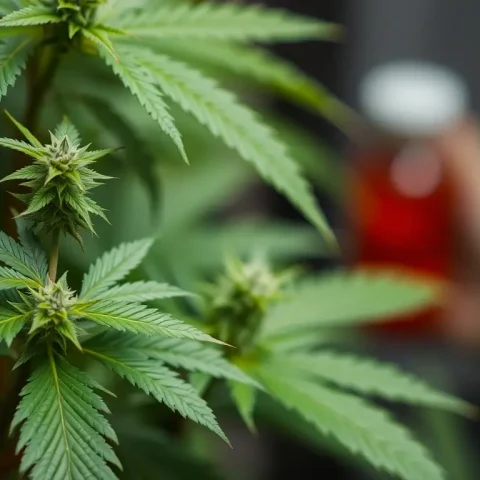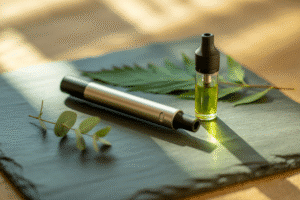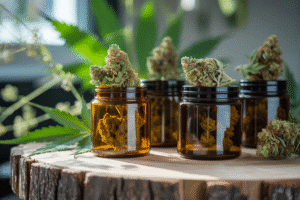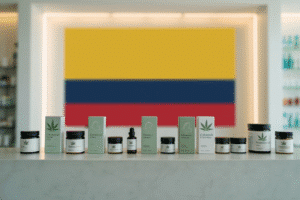- Compare Effects, Benefits & Research Evidence
CBG vs CBD: Science-Based Cannabinoid Guide 2025

Contents
Contents
As cannabis reform sweeps across Europe and research barriers fall, scientists are uncovering the unique properties of individual cannabinoids. While CBD (cannabidiol) has dominated the wellness market, CBG (cannabigerol) emerges as a promising compound with distinct mechanisms and applications. This evidence-based analysis explores how these non-intoxicating cannabinoids differ in their effects, availability, and therapeutic potential (CBG vs CBD).
Understanding the science behind CBG and CBD helps consumers make informed choices in an evolving market. From receptor interactions to clinical evidence, we examine what current research reveals about these compounds—separating marketing hype from scientific reality.
The Science of Cannabinoids: CBG and CBD Fundamentals
Cannabis contains over 100 cannabinoids, but two non-intoxicating compounds stand out for their therapeutic potential. CBG serves as the biosynthetic precursor to many cannabinoids through its acidic form CBGA, earning it the nickname “mother cannabinoid”. CBD, meanwhile, has achieved mainstream recognition with FDA-approved applications for specific seizure disorders.
CBG (Cannabigerol)
- • Biosynthetic precursor via CBGA
- • Low natural abundance (typically <1%)
- • Non-intoxicating properties
- • Emerging research compound
CBD (Cannabidiol)
- • Abundant in hemp varieties
- • FDA-approved for epilepsy (Epidiolex)
- • Non-intoxicating properties
- • Extensive research base

Key Distinction: Availability and Cost
CBG’s low natural abundance makes extraction costly, resulting in higher prices compared to CBD products. Advanced breeding programs aim to develop high-CBG cultivars to improve commercial viability.
Mechanisms of Action: How CBG and CBD Work Differently
Understanding how cannabinoids interact with the body’s receptors reveals why CBG and CBD produce different effects. While both are non-intoxicating, their receptor binding profiles and downstream effects vary significantly.
Receptor Interactions Comparison
| Receptor System | CBG Activity | CBD Activity |
|---|---|---|
| CB1/CB2 Cannabinoid | Low affinity; potential modulation | Negative allosteric modulator at CB1 |
| 5-HT1A Serotonin | Antagonist (blocks receptor) | Agonist (activates receptor) |
| α2-Adrenergic | Agonist activity reported | Limited interaction |
| TRPV1 Vanilloid | Under investigation | Agonist (desensitizing effect) |
CBG’s antagonism at 5-HT1A receptors contrasts sharply with CBD’s agonist activity at the same site, potentially explaining differences in their effects on mood, nausea, and appetite regulation.
Clinical Significance
These mechanistic differences suggest CBG and CBD may complement each other in therapeutic applications. Their opposing actions at certain receptors could provide balanced effects when used together, though clinical evidence for combination therapy remains limited.
Evidence-Based Benefits: Separating Research from Marketing
The therapeutic potential of cannabinoids varies dramatically in terms of supporting evidence. While CBD benefits from extensive clinical research, CBG studies remain largely preclinical.
CBG: Emerging Research Areas
Antibacterial Properties
In vitro studies demonstrate CBG activity against resistant bacteria including MRSA biofilms. Clinical trials needed.
Inflammatory Bowel Disease
Mouse colitis models show reduced inflammation with CBG treatment. Human studies pending.
Neuroprotection
Antioxidant properties observed in Huntington’s disease models. Early-stage research only.
CBD: Established Applications
Epilepsy (FDA-Approved)
Epidiolex approved for Lennox-Gastaut, Dravet, and TSC-associated seizures. Prescription-only.
Anxiety and Sleep
Mixed clinical evidence with heterogeneous products/dosing. CDC notes need for more research.
Pain and Inflammation
Multiple receptor pathways implicated. Clinical outcomes vary by condition.
Critical Research Limitations
Most CBG research remains preclinical (cell cultures and animal models). Human clinical trials are essential before making therapeutic claims. Over-the-counter products lack the standardization and oversight of pharmaceutical preparations.
Practical Guide: Choosing Between CBG and CBD
While individual responses vary, current evidence suggests different applications for each cannabinoid based on their mechanisms and research support.
Evidence-Based Application Guide
😊
Stress & Anxiety
CBD (Better studied)
🎯
Focus & Clarity
CBG (Theoretical)
💪
Pain & Inflammation
CBD (More evidence)
🍽️
Appetite Support
CBG (Preclinical)
😴
Sleep Quality
CBD (Mixed data)
🦠
Antibacterial
CBG (In vitro only)
Quality Control Essentials
- • Request recent Certificates of Analysis (CoAs) showing cannabinoid content
- • Verify third-party testing for contaminants (pesticides, heavy metals, microbes)
- • Start with low doses and titrate slowly
- • Consult healthcare providers about drug interactions
Legal Status in Greece: Evidence-Based Regulation
Greece follows EU-wide trends toward evidence-based cannabis regulation, distinguishing between hemp-derived products and high-THC cannabis.
Greek Cannabis Regulatory Framework
Legal Products
- • Hemp-derived CBD (≤0.2% THC)
- • CBG from compliant hemp
- • Medical cannabis (prescription only)
- • Industrial hemp products
Illegal Products
- • High-THC cannabis (recreational)
- • Products exceeding THC limits
- • Novel cannabinoids (HHC, THCP)
- • Unregulated imports
The EU Drug Agency notes that hemp-derived CBD products must comply with national regulations beyond agricultural THC thresholds, including appropriate marketing claims and quality standards.
Travel Considerations
International travel with CBD/CBG products remains complex due to varying national laws. Purchase products locally in Greece from reputable retailers to avoid customs issues. Always retain proof of THC compliance.
The Future of Cannabinoid Therapeutics
As cannabis reform progresses globally, research into individual cannabinoids accelerates. The distinct mechanisms of CBG and CBD suggest potential for targeted therapeutic applications and combination therapies.
Research Priorities Moving Forward
- Clinical Trials: Moving CBG research from preclinical to human studies for validation of therapeutic claims
- Standardization: Developing pharmaceutical-grade preparations with consistent potency and purity
- Combination Studies: Investigating synergistic effects of CBG+CBD formulations
- Safety Profiles: Long-term studies on chronic use, drug interactions, and special populations
- Bioavailability: Optimizing delivery methods for improved therapeutic outcomes
Evidence-Based Progress
Like Slovenia’s rational approach to cannabis reform, cannabinoid therapeutics advance through scientific rigor rather than marketing claims. Consumers benefit when regulation follows evidence, ensuring safe access to quality-controlled products with validated benefits.
Conclusion: Making Informed Choices
CBG and CBD represent distinct therapeutic opportunities within the cannabinoid family. While CBD benefits from extensive research including FDA approval for specific conditions, CBG shows promise in preclinical studies that await human validation. Understanding their different mechanisms helps consumers navigate an evolving market with realistic expectations.
As research progresses and regulations evolve, evidence-based approaches to cannabinoid therapeutics will continue revealing new applications. Whether choosing CBD’s established benefits or exploring CBG’s emerging potential, prioritize quality products with transparent testing and consult healthcare providers for personalized guidance.
Medical Disclaimer: This article provides educational information only. Consult healthcare professionals before using cannabinoid products, especially if taking medications or managing health conditions.




